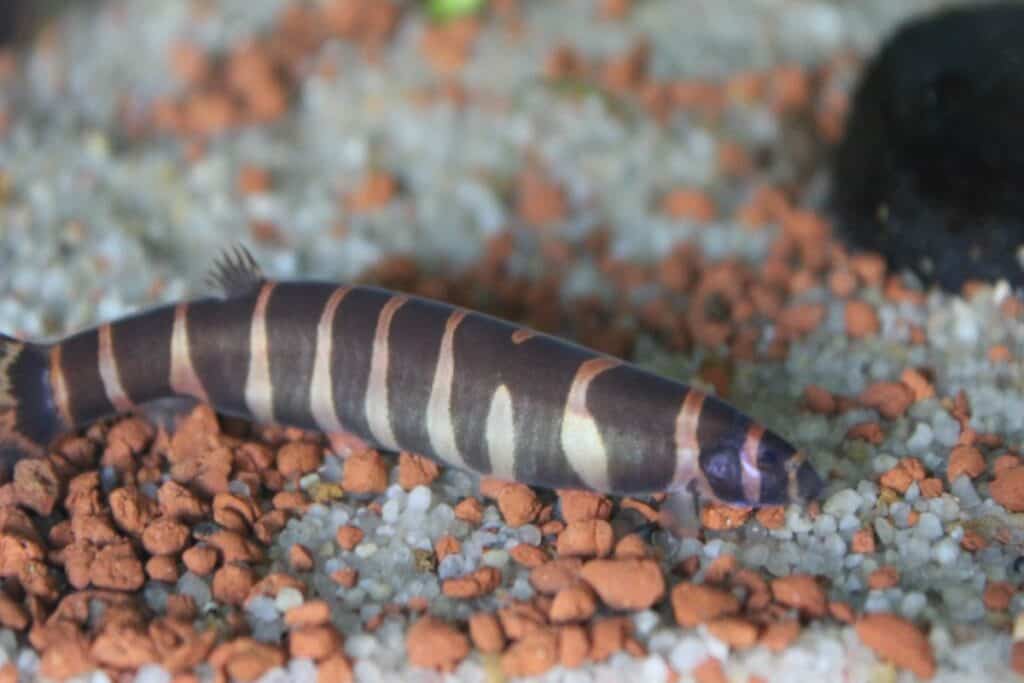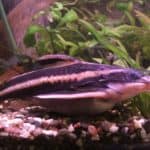If you’re like most aquarium owners, you’re probably concerned about keeping your tank clean and algae-free. But what if you could reduce the risk of algae problems by getting a fish that feed on algae? Fish that are known to clean their own tank include the Coolie Loach, which is considered an exotic specie, but has become increasingly popular — showing all its beauty in many aquariums around the world.
To know more about the Coolie Loach, take your time to read this comprehensive guide.

Species Summary
Native to Southeast Asia, the Coolie Loach (Pangio kuhlii) is a valuable addition to any aquarium, as it is known to be easy to care for and super hardy. This beautiful fish features a slender body, resembling an eel or even a snake.
It spends most of its time at the bottom of the aquarium, mainly digging in the sand and exploring in search of food and refuge. It has a better quality of life when kept in groups of more than six individuals. When kept alone in an aquarium, it is pretty shy and will spend most of its time in hiding. Additionally, the Coolie Loach helps keep the aquarium calm and peaceful as this fish can coexist with other peaceful species without problems.
But there’s one significant drawback, the Coolie Loach doesn’t support poorly oxygenated waters, unlike other cobitids. This means that if you have a tank that’s not well-maintained, the Coolie Loach may not do well.
Coolei Loach Care Guide
If you are planning on adding a Coolei Loach to your tank, there are initial requirements you need to be aware of.
Tank Size
The animal is relatively small and always lives in the lower part of the aquarium. An aquarium with 18 gallons in volume can house up to 5 Coolie Loaches, making it a suitable environment for a small group.
If you want to add large groups, you should add about 3 gallons for each additional individual. The height of the tank is not particularly important.
Tank Mates
The Coolie Loach can coexist with several fish species in the aquarium due to its reputation for being peaceful. However, avoiding large and territorial species such as medium to large cichlids would be beneficial. Small, peaceful fish like Rasboras, Tetras, Danios, and Barbs also make great tank mates.
This fish is a social creature that requires the company of its own kind to thrive. In an 11-gallon aquarium, a group of 6 Coolie Loach should be introduced.
It is not recommended to associate any other fish with small Coolies in a tiny or nano tank; the food competition and the stress generated would be fatal for the Coolies.
Same Species Tanks
The Coolie Loach is not often used in species-only tanks because of its behavior.
Water Parameters
The natural habitat of the Coolie Loach is based on sandbed biotopes in slow-moving rivers in lowland forests and clean mountain streams, with excellent quality, crystalline, and well-oxygenated water. Kuhlis live natively in a tropical climate and prefer water with a pH of 5.5 to 6.5 but tolerate pH 7.0 with low hardness.
The ideal aquarium to keep these fish has a pH between 6.0 to 7.0, a hardness of 1 to 5, and a temperature of 75 to 86 F.
What to Put in Their Tank
It is best to avoid adding these fish to an aquarium that is not adequately cycled, as they require good-quality water. While the Coolie Loach can survive in environments with low oxygenation, it is still recommended that the filtration be powerful.
The aquarium’s decorations will differ based on personal preference, but it is essential to have a fine gravel or sand substrate to prevent the animal from injury. You can add, for example, some big smooth rocks and leave them scattered along with some pieces of logs and roots to form hiding places. In addition, the Coolie Loach is a curious fish and enjoys exploring, so ensure there are plenty of caves and crevices.
In order to study and observe this species, a unique aquarium is required that contains simple upturned pots and pieces of plastic tubes. The composition and physicochemical qualities of water are of little importance. On the other hand, escape attempts are to be feared. It is also advisable to transport fish in a plastic bag by inverting the bag to reduce the risk of the fish being crushed under a fold.
As with other Cobitids, handling requires a lot of care to avoid getting the thorn under their eye in the meshes of the landing net. Finally, remember that they love to jump, so don’t forget to put a tight lid on to prevent possible escapes.
Common Diseases
Though they are quite hardy fish, Coolie Loaches may become easily stressed by changes in their surroundings and may take several days or even weeks to readjust. Not only that, they are also susceptible to external parasites like Ich. This predisposition happens because they do not have a very developed epithelium cover.
Food and Diet
The Coolie Loach’s natural diet consists mainly of insects, larvae, and small crustaceans, which it sifts through its mouth and gills. It also feeds on detritus and plant matter to a lesser extent.
In captivity, this species of fish is known to accept both dry and live food sources, and requires a regular intake of plant material. Its preference is to feed during the night, though it quickly learns to eat during the day if necessary.
Ultimately, the key to feeding the Coolie Loach is to remember that they need little food that sinks.
Lifespan
The Coolie loach is a long-lived fish with a lifespan of around 15 years. It is relatively robust and resistant to diseases.
Appearance
This loach has a salmon-colored, serpentine body with dark spots. Ten to fourteen broad, dark brown vertical stripes run down the length of its belly and stand in contrast to the light-colored background.
The mouth has three barbels to allow the fish to search the ground for food. The eyes have the particularity of being covered with a light membrane.
Characteristically, there is an erectile pimple under its eyes, as with all Cobitidae. The pectoral fins are in the abdominal position, and the dorsal fin is set back very significantly.
Size
The Coolie Loach is a slender fish which easily reaches over 4 inches when well-fed.
Behavior and Temperament
The species is nocturnal, spending most of its time buried in the substrate and only appearing sporadically to feed. It is not uncommon to go several weeks without seeing it in the aquarium.
If you wish to see more significant agitation among the species in your aquarium, it is recommended that you keep them in groups with at least six specimens to feel safer and more comfortable swimming in all corners, increasing the chances of not getting buried so often.
Besides, the Coolie Loach can endure adverse conditions inside an aquarium and can even live in environments with oxygen levels below the standard amount, as its intestinal mucosa performs respiratory functions.
The Coolie Loach is generally a reclusive fish, spending the majority of its time hidden among decorations, plants, and hiding places formed with rocks or logs. It is not uncommon to see these fish come to the surface, especially during dawn, in order to breathe oxygen.
Breeding
The successful reproduction of Coolie Loaches in aquariums is rarely seen, although there have been some instances where hormones have been injected to induce it. The available information on this subject is limited. There are a few reports, but they lack scientific detail about the rearing of the young, and there is no information about the success rates of reproduction.
The Coolie Loach is an oviparous fish which spawns on surface roots or floating plants after the male and female swim together and intertwine. The eggs of this fish are greenish in color. Besides, parents do not care for the offspring and may eat the eggs and larvae.
In nature, the Coolie Loach spawns communally in very shallow water. Captive breeding requires a large amount of space, hiding places, and water quality that is consistent and impeccable. Egg dispersal occurs when the fish release their eggs and are fertilized.
What about fertilization? Well, it only occurs in very tall aquariums (at least 23 inches) because the female requires a change in hydrostatic pressure to expel her eggs. The incubation period generally lasts around 24 hours, and the temperature required for successful breeding is typically around 78 F.
Gender Differences: Male vs Female
Sexual dimorphism is not very evident in Coolie Loaches. Females have a larger ventral region (more swollen), with a more robust and slightly larger body than males. In comparison, males are slimmer, with a smaller body size.
Also, sexual maturity in males is marked by the first ray of the first pectoral fin, which is thicker and more branched than in other fish. It has also been noted by some sources that the male can be distinguished from the female by spots (or just one) on the pectoral fins, which can be attributed to confusion, given that the pectoral fins of the males are noticeably larger.
Coolie Loach Fun Facts
- The term “Kuhli” is widely used to designate several species of the genus Pangio collectively and several species are very similar to Pangio kuhlii.
- P. kuhlii has a pinkish yellow background color with about 12 to 17 dark vertical stripes and 3 stripes on its head. It has no scales on its head, and its eyes are covered by transparent skin, in addition to having three pairs of barbels near its mouth. Small dorsal fin and the anal fin is defined at the base end of the dorsal. May be confused with P. myersi.
- Species of this genus are commonly referred to as Eels Loach but are distinguished from other Cobitids by the long, thin body shape, relatively high number of vertebrae, and the position of the dorsal fin which is situated well behind the origin of the pelvis (compared in front, above or just slightly back).
- All cobitids have sharp subocular spines, which are normally hidden inside a pouch.
References
ASAP, Aquarium Science Association of the Philippines, 1996. Aquarium species in the Philippines. ASAP Aquarist Database Report. 9 p. Quezon City, Philippines.
Francis-Floyd, R., & Reed, P. (1991). Ichthyophthirius multifiliis (white spot) infections in fish. Florida Cooperative Extension Service, Institute of Food and Agricultural Sciences, University of Florida.
Riehl, R. and H.A. Baensch, 1991. Aquarian Atlas. Band 1. Melle: Mergus, Verlag für Natur-und Heimtierkunde, Germany. 992 p.Robins, C.R., R.M. Bailey, C.E. Bond, J.R. Brooker, E.A. Lachner, R.N. Lea and W.B. Scott, 1991. World fishes important to North Americans. Exclusive of species from the continental waters of the United States and Canada. love Fish. social Spec. Publish (21):243 p.








